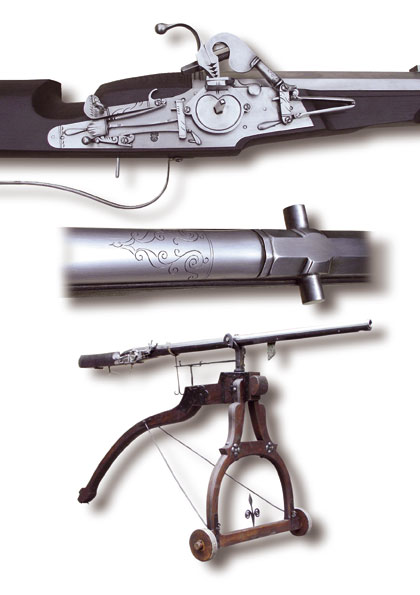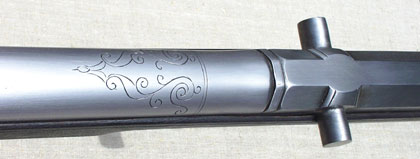Large "Wall Gun" (Doppelhaken) on Carriage Mount,
propably Suhl around 1620
 Reproduction of a "Doppelhaken" based on an original in the art collections of the castle of Coburg, Inv. Nr. IV. D. 45. Propably of Suhl origin, by Valentin Klett around 1620. Reproduction of a "Doppelhaken" based on an original in the art collections of the castle of Coburg, Inv. Nr. IV. D. 45. Propably of Suhl origin, by Valentin Klett around 1620.
Total length: 228 cm
Barell length: 169 cm
Calibre (Bore):
27 mm, slightly swamped at the nozzle to 30 mm
Weight: 19 kg (base not included)
Remarkable heavy "hackbut". At the beginning of the the upper third, forge-attached to the barrel, the typical saw-toothed hook. Octagonal to round tapered barrel, engraved with ornamentations and decorated with filed and cut cannelures. Soldered bead and dovetail notch. Attached to the middle section two trunnions to mount the gun into a carriage or trestle mount. Heavy wheellock, combined with match-snaplock, with spring-loaded sliding pan cover and surface mount sear-lever blocking safety.

The gun in full lenght of 228 cm (7 ft. 6"). Clearly to recognize the forge-attached hook at the upper third of the barrel, which gave this weapon it's german name. The hook was counter-placed against a wall-ballustrade or a wooden buffer beam, in order to reduce the tremendous recoil.
Actually there is no exact english translation or equivalent for the german term "Doppelhaken", which weapon was widely in use within the german war theatre up to 1648. The english name "hackbut, hackbush", derived from the term "arquebuse" ("Hakenbüchse" = "hook gun"), which is mostly related to the cumbersome handgonnes (with barrel hook) of the 1400s and early 1500s, would not adequately descripe this kind of weapon. Actually the term "Hakenbüchse", normally shortened as "Haken" ("hook"), can be found in german terminology for a much longer time period (compared to sorrounding european countries) and can be found in many german arsenal inventory lists untile mid of the 17th century. In Germany the term "Haken" was clearly derived from the barrel hook, not, as other theories state, from the hook-type stockshape of late arquebuses, the "culatta castellana" which in german language are descrpiped as "Spanish stock". The german family of "Haken" firearms was split into 3 categories: the "semi" or "half hook" ("Halber Haken"), which term was basicly used for the short arquebuses of the 16th century without a barrel hook, which by the end of the 16th/beginning 17th century evolved into the short carbine or "bandolier gun". The "whole or full hook" ("Ganzer Haken"), mostly without barrel-hook, which by the third quarter of the 16th century had migrated into the musket. And finally the "Doppelhaken" ("double hook"), a large bore and heavy weapon, always equipped with a barrel hook, which as a weapon and a term remained in use far into the 17th century. The barrel-hook also clearly differentiates the "Doppelhaken" from a "Wallbüchse" (Wall Gun), which normally misses the barrel-hook, instead was mounted on a carriage or a swivel base. (Actually "Wall" in german language means rampart, not a brick-layed building). The weapon desciped on this page actually features both: a barrel hook and trunnions to be attached to a carriage mount.
"Doppelhaken" were not so much developed for use in field but rather for defendance of fortified places, whrere they were capable to shoot large calibre lead balls relatively exactly over larger distances. This weapons were especially usefule to shoot at the opponents artillery batteries, as with a calibre of up to 1 1/8" (24-28 mm) and a bullet weight of roughly a quarter of a pound, even sheltered ordnance batteries and wooden barricades could be penetrated.

Alternatively the Doppelhaken could be mounted on a carriage, using the two trunnions attached to the barrel. This was the method of choice with stationary placement of this weapon, as it allowed more exact aiming towards the target.
Buttplate of the giant stock, showing an inventary number of the Veste Coburg arsenal. The original Suhl proof marks ware replaced with manufacturing marks of Armin König.
Detail look at the wheellock with combined slowmatch snaplock. The sliding pan cover automaticly closes when pushing the button beyond. The savety lever at the left area of the lockplate blocks the sear lever, which is reaching through the lockplate from the inner lock to outside. The diameter of the ring-shape coverd wheel is 51 mm ( 2 inch). The lock has an overall weight of 1.5 kg.
Same view at the lock with slowmatch snaplock activated. The appropriate machanism is fairly simple. The serpent is blocked by a slidable sear. With safety lever removed, the sear is pushed foreward, when pulling the drigger, causing the spring-loadeds serpend to push the slowmatch into the pan. For detailed functions of the wheellock see the appropriate article in the main menue.
Diagonal top-view of the lock area, showing the chiseld year digits 1624 (not at the original).
The barrel with a calibre bore of 27 mm (1.06") is widened at the muzzle towards 30 mm, to provide a more conveniant insertion of the ralatively long ramrod. From this bore a slightly unter-calibred lead ball of 25-26 mm (1 inch) and a bullet weight of appr. 100 gramms was fired.
Back to Firearms
|
|